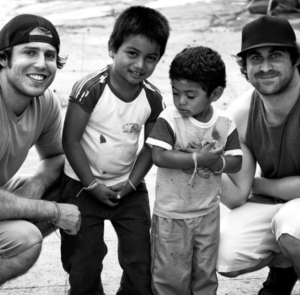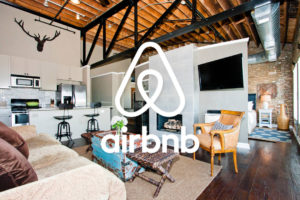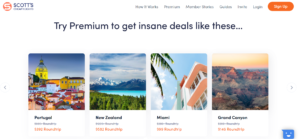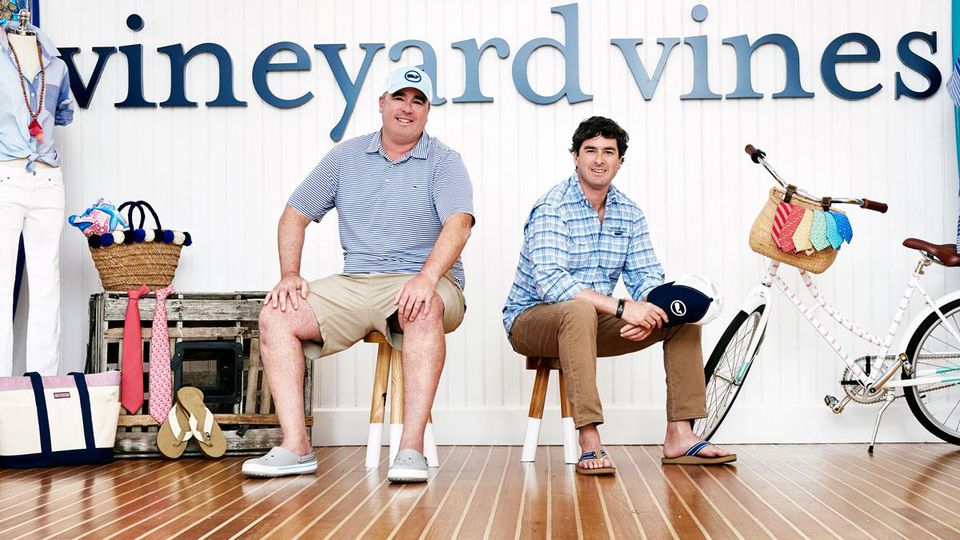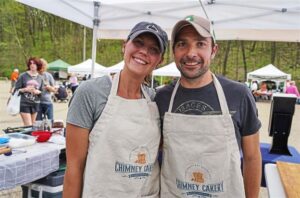 Bill and Jen Ehninger were on a trip to Budapest when they discovered the inspiration for their business: Kürtőskalács. Kürtőskalács are cone-shaped pastries cooked to a caramelized finish and rolled in cinnamon sugar or nuts or filled with jam, chocolate, or cream. Hundreds of vendors sold these pastries in Budapest, and when the Ehningers fell in love with them, they decided that they needed to bring them to the United States. So, the couple attended a one-day class at the Kurtos Academy in Murska Sobota, Slovenia where they learned the art and became certified chimney cake bakers.
Bill and Jen Ehninger were on a trip to Budapest when they discovered the inspiration for their business: Kürtőskalács. Kürtőskalács are cone-shaped pastries cooked to a caramelized finish and rolled in cinnamon sugar or nuts or filled with jam, chocolate, or cream. Hundreds of vendors sold these pastries in Budapest, and when the Ehningers fell in love with them, they decided that they needed to bring them to the United States. So, the couple attended a one-day class at the Kurtos Academy in Murska Sobota, Slovenia where they learned the art and became certified chimney cake bakers.
In 2022, they opened Chimney Cakes, a boutique mobile bakery business, and attended several farmers markets. They decided to give it a year to see how it did – and they met with success as they have added more farmers markets and even offer catering! Chimney cakes are yeasted sweet dough wrapped around a wooden stick before being cooked on their imported gas chimney cake grill to get a caramelized finish. The Ehningers have added their own twist by incorporating orange zest and juice in the sweet dough and even offering some savory chimney cakes. These are a fun and unique dessert, and “people love them because they’re new and different, and they also like to see the process from beginning to end, and they taste wonderful!” as Jen explained.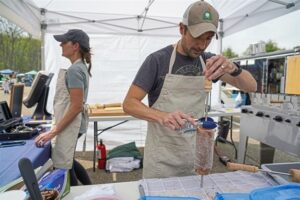
The Ehningers discovered something that they loved and found a new niche in bringing it to the US. They were dedicated to their idea, getting certified in chimney cake baking, but they also added their own unique twits. Additionally, they recognized their lean start up when they decided to give Chimney Cakery a year to test their idea. They created a business which engages customer who can watch the whole process and even create their own chimney cake. Bill and Jen Ehninger have shared their love of this Hungarian pastry by bringing Chimney Cakes to north-west PA.
Visit their website at https://www.chimneycakery.com/.
 Caleb Nelson asked his father if he could borrow $10,000 for a business plan that he had in mind. His plan was a to create a business that used pedicabs, which are carts that are connected to the back of bicycles, to transport people around town. Caleb made a presentation that talked about his plans and showed it to his father. His father decided to give Caleb $5,000 if he could make the rest of it by himself. Caleb was only 14 years old at the time, so it seemed to be quite a challenge. However, he found a way to raise the $5,000 and Caleb and his father were on their way to Denver to purchase two pedicabs. With the help of some of his friends from middle school, Caleb officially launched Romeo’s Rickshaws. He has said that he is most grateful for everything that he has learned. He recognized that it was difficult for any business to stand out, because there were so many advertisements for the festival’s program. Caleb made the advertisements for Romeo’s Rickshaws not only stand out, but the people who are in charge of the pedicabs are taught to guide riders to advertisers. He also learned about how to get people to show up. There is no charge for a ride and the people only pay tips to the operators. Despite his accomplishments, Caleb does not see his business being a permanent venture. He says it is because it takes a lot of work. As of the date of the article, Caleb is 17 years old and is intending to sell the pedicabs before he leaves for college. He also intends to remember the lessons that he learned from his business.
Caleb Nelson asked his father if he could borrow $10,000 for a business plan that he had in mind. His plan was a to create a business that used pedicabs, which are carts that are connected to the back of bicycles, to transport people around town. Caleb made a presentation that talked about his plans and showed it to his father. His father decided to give Caleb $5,000 if he could make the rest of it by himself. Caleb was only 14 years old at the time, so it seemed to be quite a challenge. However, he found a way to raise the $5,000 and Caleb and his father were on their way to Denver to purchase two pedicabs. With the help of some of his friends from middle school, Caleb officially launched Romeo’s Rickshaws. He has said that he is most grateful for everything that he has learned. He recognized that it was difficult for any business to stand out, because there were so many advertisements for the festival’s program. Caleb made the advertisements for Romeo’s Rickshaws not only stand out, but the people who are in charge of the pedicabs are taught to guide riders to advertisers. He also learned about how to get people to show up. There is no charge for a ride and the people only pay tips to the operators. Despite his accomplishments, Caleb does not see his business being a permanent venture. He says it is because it takes a lot of work. As of the date of the article, Caleb is 17 years old and is intending to sell the pedicabs before he leaves for college. He also intends to remember the lessons that he learned from his business.